About Us

We pride ourselves in offering affordable care to all our patients, with our fees usually being below the national average.
We have a wonderful team who are dedicated to making your treatment an enjoyable experience. Our staff believes in establishing long-term relationship with our patients and working together to create great smiles!
At Braces at Rockhampton, we understand that good communication and co-operation is essential in achieving a successful orthodontic outcome. Therefore, we will always spare the time to listen to your goals, explain our treatment and answer your questions.
We look forward to seeing you soon!
Why Straighten Teeth
Alignment of teeth can be beneficial in many ways.
Appearance: In today’s society we are becoming increasingly cosmetically conscious. A beautiful smile is a great asset to have in social interactions. Orthodontic treatment can give straight teeth and an attractive smile which improves Self-esteem.
Confidence: Patients who are unhappy with their teeth may hide them and not smile. Well aligned teeth can enhance your confidence, and change the way both you and others see yourself. In this way, orthodontics can benefit you both professionally and socially.
Dental hygiene: It’s more difficult to keep your teeth clean when they are crowded and overlapping. This can make you more prone to plaque build-up and subsequent decay and gum disease. Furthermore, you may find that food constantly gets packed between your teeth. Straight teeth are easier to keep clean, therefore reducing the risk of cavities and periodontal disease.

Tooth wear: An uneven bite can lead to uneven wear of the teeth. Aligning your teeth properly can stop this from occurring.
Gum damage: In severe malocclusion, the lower teeth may bite on the gums of the palate causing them to be stripped away. In Long-term this can lead to periodontal problems and tooth sensitivity. Orthodontics can eliminate traumatic bites such as these and improve the health of your oral tissues.
Speech: Some people have difficulty speaking because of poor alignment of the teeth and jaws.
Eating: A malocclusion can reduce our ability to chew food properly. By improving the occlusion, we can bite and chew more effectively.
Orthodontic problems
Which conditions need braces
There are many different malocclusion’s or bad bites.
- Crowded teeth
- Spacing
- Overjet
- Deep bite
- Open bite
- Under-bite
- Cross-bite
- Ugly-duckling stage
- Missing teeth
- Impacted canines
- Thumb sucking
Crowded teeth
When there are too many teeth or the teeth are too large for the jaws, crowding can result and the teeth become irregular. This can be unattractive, difficult to clean, prone to uneven wear, and prone to food packing. Orthodontic treatment usually involves expanding the jaws or removing teeth to create space, followed by braces to align the teeth in a harmonious position in the smile.
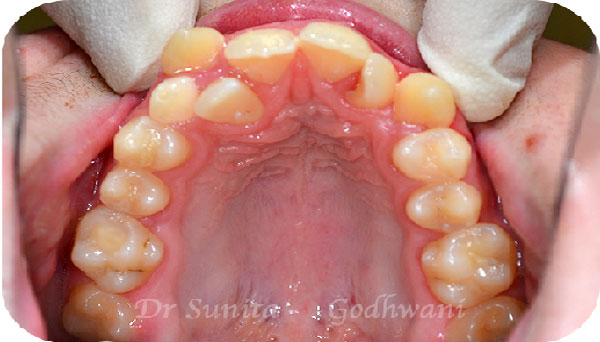
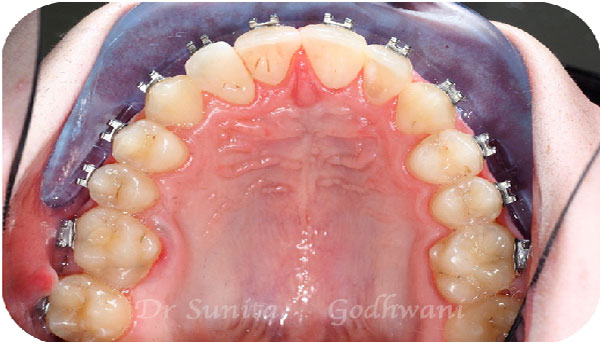
Crowded teeth


When there are too many teeth or the teeth are too large for the jaws, crowding can result and the teeth become irregular. This can be unattractive, difficult to clean, prone to uneven wear, and prone to food packing. Orthodontic treatment usually involves expanding the jaws or removing teeth to create space, followed by braces to align the teeth in a harmonious position in the smile.
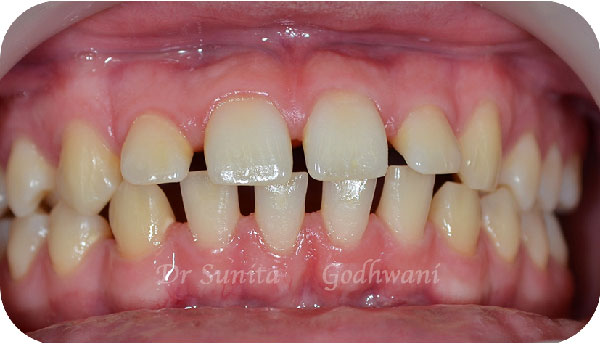
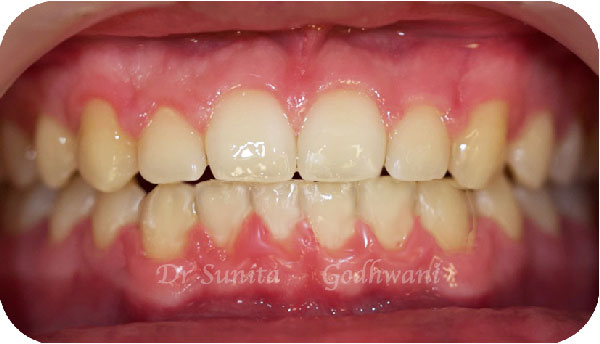
Spacing
Spacing or gaps can result when there are missing teeth or the teeth are too small. These spaces are often unattractive and can interfere with one’s speech. Treatment usually involves bringing the teeth together to close the spaces or liaising with the dentist to build up the teeth back to their normal size. Occasionally, a large tongue may be causing the teeth to be pushed out hence creating spacing. In this situation, the abnormal tongue position needs to be addressed.
Spacing


Spacing or gaps can result when there are missing teeth or the teeth are too small. These spaces are often unattractive and can interfere with one’s speech. Treatment usually involves bringing the teeth together to close the spaces or liaising with the dentist to build up the teeth back to their normal size. Occasionally, a large tongue may be causing the teeth to be pushed out hence creating spacing. In this situation, the abnormal tongue position needs to be addressed.
Overjet
An overjet refers to protruding upper front teeth. There is an increased horizontal distance or overlap between the upper and lower anterior teeth. In severe cases, this protrusion may prevent the lips from sitting closed at rest and the patient may have constantly opened lips (incompetent lips). The lower lip may also become trapped behind the protruding teeth (lower lip trap), causing it to worsen the overjet. Protruding teeth can be unattractive and prone to injury –especially in young active children and older children who play sport. Sometimes the lower front teeth can even bite on the gums behind the upper teeth causing long-term gum damage and stripping. Orthodontic treatment usually involves bringing the top teeth back and the lower teeth forward. This can be achieved using braces and rubber bands, or a functional appliance.
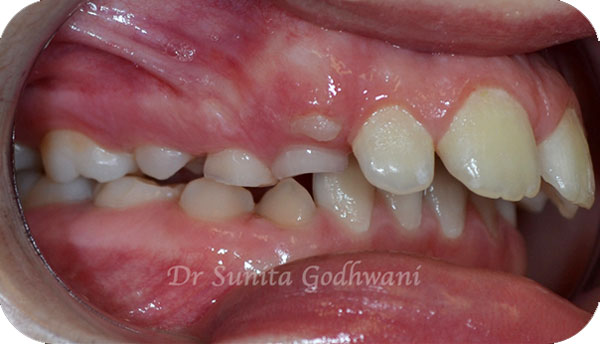
Overjet

An overjet refers to protruding upper front teeth. There is an increased horizontal distance or overlap between the upper and lower anterior teeth. In severe cases, this protrusion may prevent the lips from sitting closed at rest and the patient may have constantly opened lips (incompetent lips). The lower lip may also become trapped behind the protruding teeth (lower lip trap), causing it to worsen the overjet. Protruding teeth can be unattractive and prone to injury –especially in young active children and older children who play sport. Sometimes the lower front teeth can even bite on the gums behind the upper teeth causing long-term gum damage and stripping. Orthodontic treatment usually involves bringing the top teeth back and the lower teeth forward. This can be achieved using braces and rubber bands, or a functional appliance.
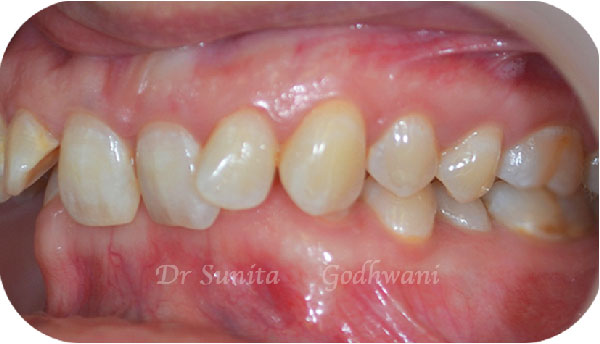
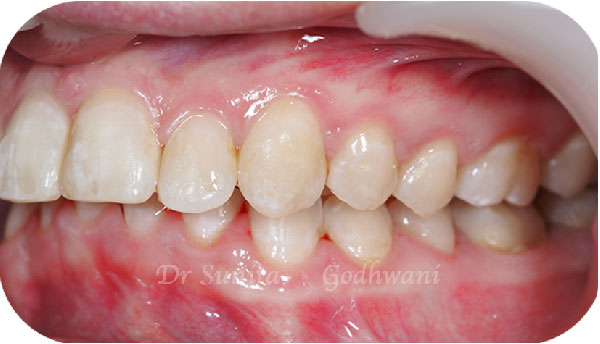
Deep bite
A deep bite refers to an increased vertical overlap between the upper and lower front teeth. This is also known as a deep overbite. In severe cases, the upper teeth can completely cover the lower teeth with 100% overlap. A deep bite can cause uneven tooth wear, gum damage, and make it difficult to eat. Treatment involves propping the bite open with braces or acrylic plates so that the teeth contact each other properly at their edges.
Deep bite


A deep bite refers to an increased vertical overlap between the upper and lower front teeth. This is also known as a deep overbite. In severe cases, the upper teeth can completely cover the lower teeth with 100% overlap. A deep bite can cause uneven tooth wear, gum damage, and make it difficult to eat. Treatment involves propping the bite open with braces or acrylic plates so that the teeth contact each other properly at their edges.
Open bite
An open bite is when the front teeth don’t meet. There are many possible causes of this from a large tongue, a thumb-sucking habit, protruding front teeth, through to a long facial skeleton. An open bite can cause eating problems, a lisp, an abnormal swallowing pattern, and may be quite unattractive in appearance. This type of orthodontic problem is notoriously difficult to treat and prone to recurring. Therefore, careful diagnosis and planning is required to give the best chance of successful open bite closure. Depending on the cause, treatment may be as simple as a thumb sucking deterrent or may involve the use of bone screws or jaw surgery.
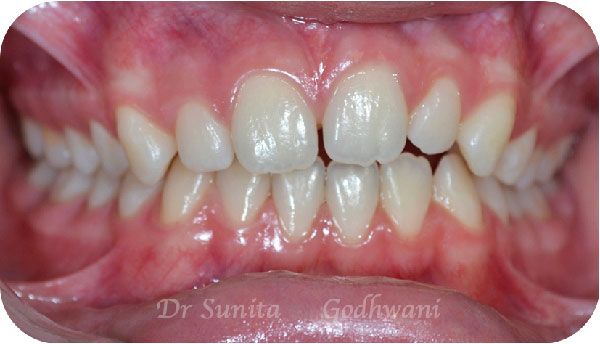
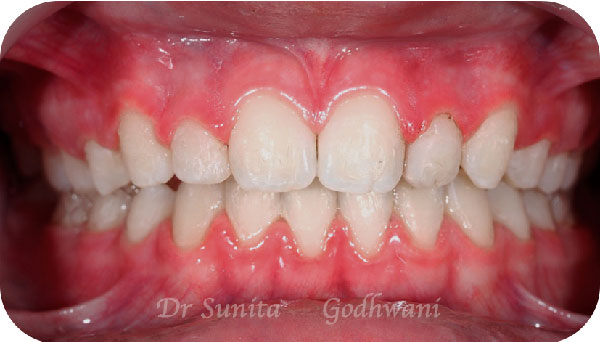
Open bite


An open bite is when the front teeth don’t meet. There are many possible causes of this from a large tongue, a thumb-sucking habit, protruding front teeth, through to a long facial skeleton. An open bite can cause eating problems, a lisp, an abnormal swallowing pattern, and may be quite unattractive in appearance. This type of orthodontic problem is notoriously difficult to treat and prone to recurring. Therefore, careful diagnosis and planning is required to give the best chance of successful open bite closure. Depending on the cause, treatment may be as simple as a thumb sucking deterrent or may involve the use of bone screws or jaw surgery.
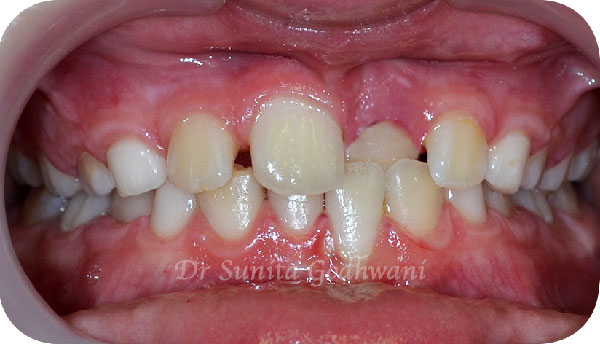
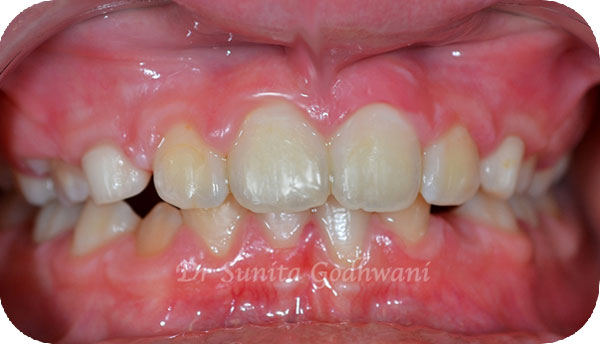
Under-bite
An under-bite is when the upper front teeth bite behind the lower front teeth. This may be due to a shift in the jaw or an excessively large lower jaw. An under-bite is quite unattractive and can cause jaw joint problems and uneven tooth wear. In mild cases, orthodontic treatment usually involves braces and rubber bands to remove any tooth interferences and allow the jaws to bite together normally. In more severe cases, jaw surgery may be recommended. This will involve moving the lower jaw back to create a more pleasing chin projection and facial outline.
Under-bite


An under-bite is when the upper front teeth bite behind the lower front teeth. This may be due to a shift in the jaw or an excessively large lower jaw. An under-bite is quite unattractive and can cause jaw joint problems and uneven tooth wear. In mild cases, orthodontic treatment usually involves braces and rubber bands to remove any tooth interferences and allow the jaws to bite together normally. In more severe cases, jaw surgery may be recommended. This will involve moving the lower jaw back to create a more pleasing chin projection and facial outline.
Cross-bite
The upper teeth should fit outside the lower teeth like a lid on a box. Occasionally, this may not occur and the upper teeth may fit inside the lower teeth. This type of bite is referred to as a cross-bite. Posterior cross-bites can occur because of a small or narrow upper jaw. In this case, the lower jaw may swing to one side to allow the back teeth to mesh. Posterior cross-bites can lead to a deviation in the chin, abnormal joint development in a growing child, strain on the jaw joint and subsequent temporomandibular disorders TMD), and excessive wear on the teeth. These problems are best intercepted early while the child is still growing. Treatment usually involves placing an expander in the upper jaw to normalize its size and hence allow the upper teeth to fit outside the lower teeth. The jaw may then close normally in its correct position.
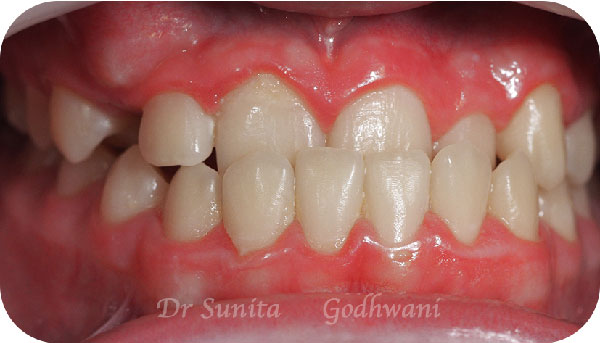
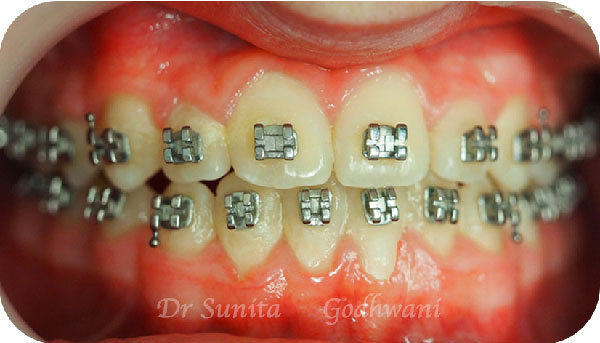
Cross-bite


The upper teeth should fit outside the lower teeth like a lid on a box. Occasionally, this may not occur and the upper teeth may fit inside the lower teeth. This type of bite is referred to as a cross-bite. Posterior cross-bites can occur because of a small or narrow upper jaw. In this case, the lower jaw may swing to one side to allow the back teeth to mesh. Posterior cross-bites can lead to a deviation in the chin, abnormal joint development in a growing child, strain on the jaw joint and subsequent temporomandibular disorders TMD), and excessive wear on the teeth. These problems are best intercepted early while the child is still growing. Treatment usually involves placing an expander in the upper jaw to normalize its size and hence allow the upper teeth to fit outside the lower teeth. The jaw may then close normally in its correct position.
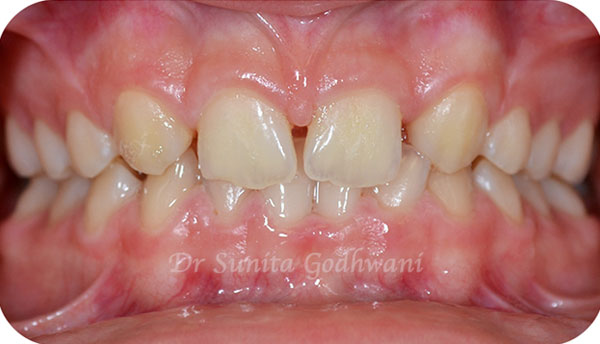
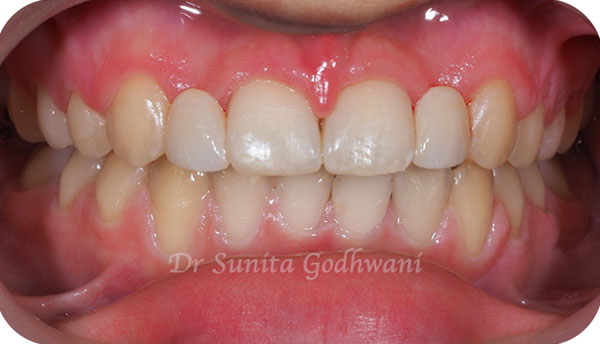
Missing teeth
Missing teeth can lead to an unattractive smile and problems eating. Orthodontic treatment usually involves one of two options in this situation. If the spaces are small it may be feasible to close them with braces by bring the adjacent teeth into the gap. However, if the spaces are too large, then treatment usually involves aligning the teeth with braces and having your dentist fill in the gap with either implants or a bridge. The decision is based on careful planning and an appreciation for what goes where.
Missing teeth


Missing teeth can lead to an unattractive smile and problems eating. Orthodontic treatment usually involves one of two options in this situation. If the spaces are small it may be feasible to close them with braces by bring the adjacent teeth into the gap. However, if the spaces are too large, then treatment usually involves aligning the teeth with braces and having your dentist fill in the gap with either implants or a bridge. The decision is based on careful planning and an appreciation for what goes where.
Impacted canines
Upper impacted canines affect about 1-2% of the population. Interestingly it is twice as common in females as it is in males. It is when the upper canines don’t erupt and become stuck on the inside of the jaw. There are many theories as to the possible causes of impacted canines but nowadays we find it is genetic. Sometimes the best treatment is prevention. Patients should be seen early on to monitor the eruption of the upper canines with visual checks and regular x-rays. If the upper canines do become impacted treatment may involve: removing the baby canines to create space for the adult ones; placing braces to open space for the adult canines; or in severe cases cutting the gum to free up the canine to allow it to erupt. Treating impacted canines can take a while but it is wise to have them fixed as these teeth are important in the smile and the bite.

Impacted canines

Upper impacted canines affect about 1-2% of the population. Interestingly it is twice as common in females as it is in males. It is when the upper canines don’t erupt and become stuck on the inside of the jaw. There are many theories as to the possible causes of impacted canines but nowadays we find it is genetic. Sometimes the best treatment is prevention. Patients should be seen early on to monitor the eruption of the upper canines with visual checks and regular x-rays. If the upper canines do become impacted treatment may involve: removing the baby canines to create space for the adult ones; placing braces to open space for the adult canines; or in severe cases cutting the gum to free up the canine to allow it to erupt. Treating impacted canines can take a while but it is wise to have them fixed as these teeth are important in the smile and the bite.
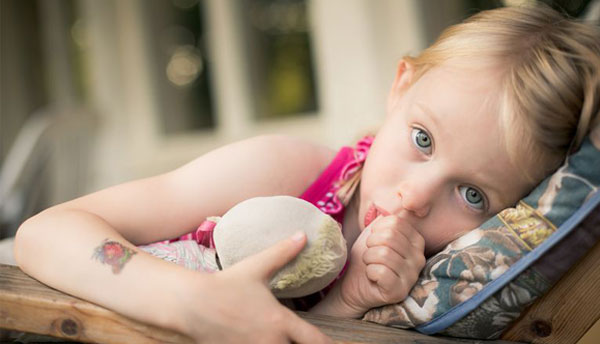
Thumb sucking
Thumb or finger sucking is relatively common in infants and young children. However if the habit persists too long, it can cause severe orthodontic problems. The upper front teeth may become protruded, an open bite may result, and the sucking pressure may constrict the top jaw causing a cross-bite. Treatment is best directed at encouraging the child to stop the habit but if this fails or in cases where the bite has already been affected an expander or plate may be placed to correct things.
Thumb sucking

Thumb or finger sucking is relatively common in infants and young children. However if the habit persists too long, it can cause severe orthodontic problems. The upper front teeth may become protruded, an open bite may result, and the sucking pressure may constrict the top jaw causing a cross-bite. Treatment is best directed at encouraging the child to stop the habit but if this fails or in cases where the bite has already been affected an expander or plate may be placed to correct things.
About Me:
I am passionate about aligning teeth and creating beautiful smiles.
Qualifications: Back in India, I have studied 5 years of Bachelor of Dental Surgery degree from University of Mumbai (1997-2002).
After graduating, I undertook three years of Post Graduate training: Masters of Dental Surgery Orthodontics 2003-06 in India.
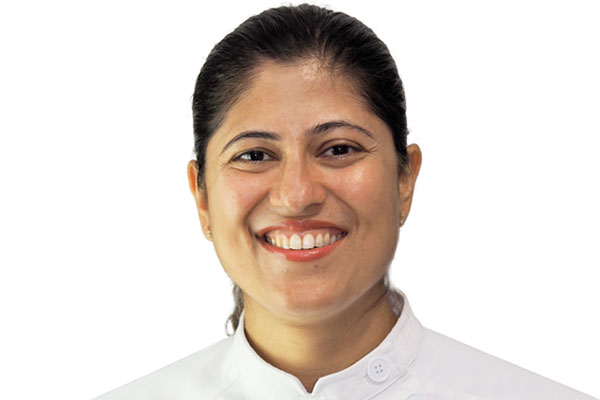
After completing Post-graduation in 2006, I started practicing Orthodontics and was also teaching both Undergraduate and Orthodontic Postgraduates as a Lecturer and later as Associate Professor before migrating to Australia.
In Australia, I’m registered as a Dentist.
My research has been published as a scientific paper in American Journal of Orthodontics and Dentofacial Orthopaedics 2012.
https://www.ajodo.org/article/S0889-5406(12)00515-X/fulltext
During spare time I enjoy spending quality time with family & friends and travelling.
